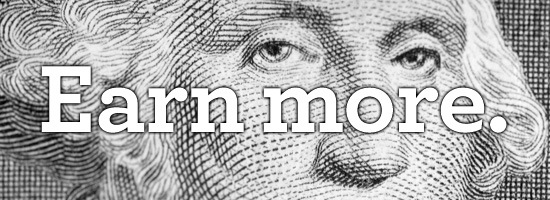- Home
- Blog
- Web Design 7 Simple Ways to Raise Your Rates and Keep Your Clients
7 Simple Ways to Raise Your Rates and Keep Your Clients
-
 7 min. read
7 min. read
-
 William Craig
William Craig CEO & Co-Founder
CEO & Co-Founder
- President of WebFX. Bill has over 25 years of experience in the Internet marketing industry specializing in SEO, UX, information architecture, marketing automation and more. William’s background in scientific computing and education from Shippensburg and MIT provided the foundation for MarketingCloudFX and other key research and development projects at WebFX.
 Raising your rates. It’s something that every freelancer wants to do, but most of us are scared to do. Or at the very least, we’re not sure how to do it.
Raising your rates. It’s something that every freelancer wants to do, but most of us are scared to do. Or at the very least, we’re not sure how to do it.
It’s natural to have questions about rate-raising. Is my work worth more? Will my clients flee at the sight of higher prices?
Will I be able to recover if they do go somewhere else? In truth, these self-doubting questions are merely assumptions. What many freelancers have found is that raising your rates rarely drives clients away. However, most of us never realize this fact simply because we never test it.
With that in mind, here are seven simple strategies to help you raise your rates and earn more – without losing your clients.
1. Prove the Value of Your Service
There is no greater tool for selling services than proof. If you can prove the value and the results that you have delivered to previous clients, then your service will sell itself regardless of price. How can you showcase your previous results in a compelling way?
Leverage the power of numbers and testimonials. People love things that are tangible. Can you get a client to tell you how much money they earned through their site last year?
Can you ask for a 30-second video testimonial or two? Prove your worth to clients and they will happily pay a higher price.
2. Develop a Clear Understanding of Who Your Ideal Client Is
If you know who your ideal client is, then you can easily increase your rates while maintaining your clients. However, if you are reaching for whatever clients you can find, then it will be very hard to earn more. Taking the shotgun approach and spraying your services all over the place is not only inefficient, it also prevents you from solving specific problems for clients.
You want clients to feel like your service was made for them. Figure out who you are well positioned to serve — be very specific. What type of businesses do they run?
What features are they looking for? What is their background in technology like? What would they want to see when hiring a designer or a developer?
Tailor your offering to their needs. If you do that, then you will be able to target a specific niche of clients and charge much, much more.
3. Schedule Your Rate Increases
If you’re not sure how to start charging more, then simply set a rate you are comfortable with and plan to increase it after a specific number of clients. For example, it could look like the following:
- First 7 clients – $40/hr
- Next 7 clients – $60/hr
- Next 7 clients – $80/hr
If you make these incremental increases a part of your business strategy, then rate-raising becomes a natural part of your business. It also makes it easier to explain to clients (if you choose to do so).
4. Offer Products as Upsells
If you’re wondering, an upsell refers to offering a paying customer a more expensive item, an upgrade, or some other add-on in the hopes that they will buy this additional item. The standard suggestion is to offer a range of services as an upsell. These items often include special offerings like long-term marketing, design, or website upgrades.
These suggestions work well, but they also end up being more work for you. Instead, think about creating a few products as upsells that clients could purchase and easily implement on their own. These products could be videos, audio, an ebook, or even a physical good.
The goal of a product upsell is to put extra cash in your wallet without an extra time commitment. How do you know what type of product to create? It’s simple.
Ask your clients what they want and then make it for them. You already have direct access to the people that will buy your upsell, which means you can easily get all the information you need to create a compelling product. You’ll be surprised how easy this is.
Some people will want to know the basics of typography or the grid system or how to take better pictures or how to get started in Photoshop or how to design their own ebooks or a million other things. All of these ideas would make reasonable products.
5. Charge for Larger Blocks of Time
Instead of thinking about what you charge per hour (or even per project), focus on billing for your time in large chunks. Take a look at your services and begin selling them in blocks of two, three, or even six months. With an hourly service, you have to constantly sell the next hour of service.
With 3-month blocks, you simply sell when you need a new client. Think about how much easier it is to sell yourself if you only have to do it a couple times per year. Additionally, a natural extension of this format is that some clients will develop long-term projects, which simply allows you to renew these large blocks of time.
Furthermore, a shift like this makes it easier for you to state a new, higher price for your services. Let’s say that previously you were charging $30/hour, but because of time spent finding new clients you were only able to bill for 30 hours per week. This means that over 12 weeks you would net $10,800. However, if you shift to selling your services in 3-month blocks, you could easily change your price to $12,000 (or even more). Not only is this a price increase for you, but it also seems totally reasonable to clients because they are viewing your offering in a different time frame. As an added bonus, you will free up all sorts of time because instead of always searching for new clients, you only need to focus on “selling” every three months or so.
Plus, you can reduce the cash flow issues that many freelancers face because you will receive large payments in advance, which allows for better financial planning and increased stability.
6. Offer Price Tiers
Instead of trying to figure all of this out in your head, let your clients decide for you. I suggest using price tiers to test what the market is willing to pay or to build your confidence in charging more.
Price Tier Example:
Let’s say that right now you charge $80/hour regardless of the job. Instead, you could offer a basic service for $80/hour, the basic package plus a small addition for $100/hour, and all of the bells and whistles for $120/hour.
You will be shocked by how often clients go for the higher priced services. The beauty of having different price tiers is that it shifts the client’s mindset from, “Should I pay you at all?” to “What price should I pay you?” Obviously, you don’t have to charge hourly to make this work. Setting price tiers for projects or long-term work is just as useful.
7. Change Your Philosophy
Your rate is determined by the value you provide and the results that you bring, not by how you feel about it. Abandon your emotional attachment to the price that you charge. Raising rates is a natural part of business.
You’re more experienced today than you were yesterday, right? Well, then you have the right to charge more because you are bringing more value to your clients. The price of goods and services all over the world continue to increase as time goes on.
It’s the way business works, and your business should be no different. Even if you put just one of these ideas into practice you can start earning more tomorrow. Change your philosophy and begin taking steps towards earning more.
What have been your most successful rate raising strategies? I would love to hear from you in the comments.
Related Content
- A Beginner’s Guide to the Business Side of Freelancing
- How to Handle Difficult Client Situations
- 20 Invoicing Tools for Web Designers
- Related categories:Project Management and Freebies
-
 President of WebFX. Bill has over 25 years of experience in the Internet marketing industry specializing in SEO, UX, information architecture, marketing automation and more. William’s background in scientific computing and education from Shippensburg and MIT provided the foundation for MarketingCloudFX and other key research and development projects at WebFX.
President of WebFX. Bill has over 25 years of experience in the Internet marketing industry specializing in SEO, UX, information architecture, marketing automation and more. William’s background in scientific computing and education from Shippensburg and MIT provided the foundation for MarketingCloudFX and other key research and development projects at WebFX. -

WebFX is a full-service marketing agency with 1,100+ client reviews and a 4.9-star rating on Clutch! Find out how our expert team and revenue-accelerating tech can drive results for you! Learn more
Make estimating web design costs easy
Website design costs can be tricky to nail down. Get an instant estimate for a custom web design with our free website design cost calculator!
Try Our Free Web Design Cost Calculator


Web Design Calculator
Use our free tool to get a free, instant quote in under 60 seconds.
View Web Design CalculatorMake estimating web design costs easy
Website design costs can be tricky to nail down. Get an instant estimate for a custom web design with our free website design cost calculator!
Try Our Free Web Design Cost Calculator




